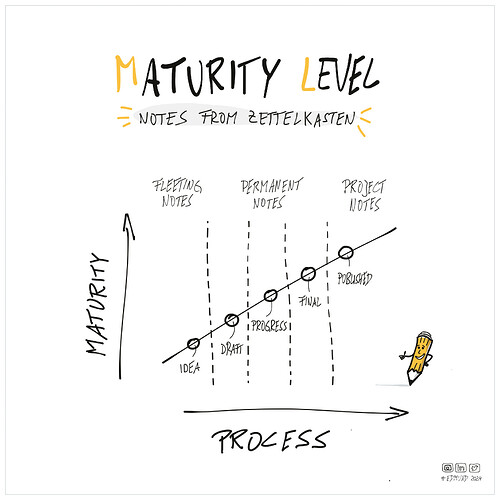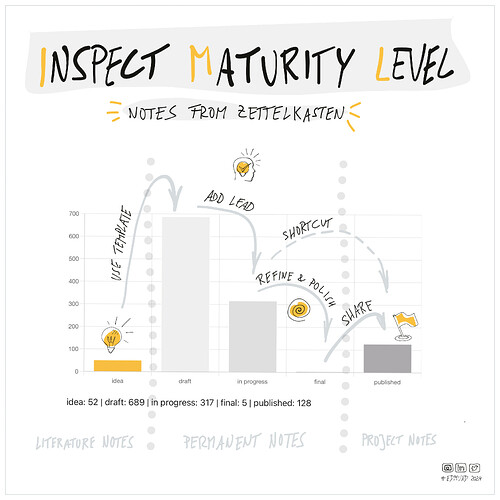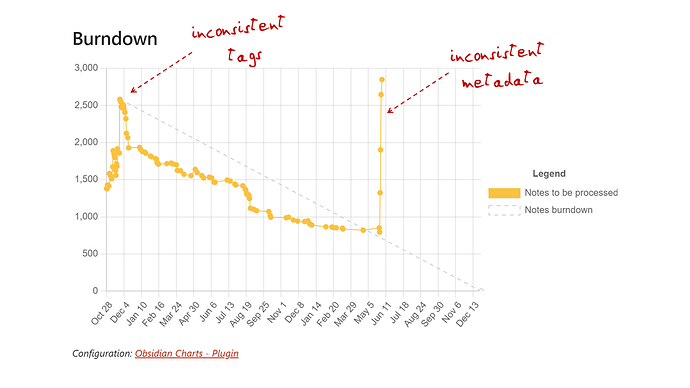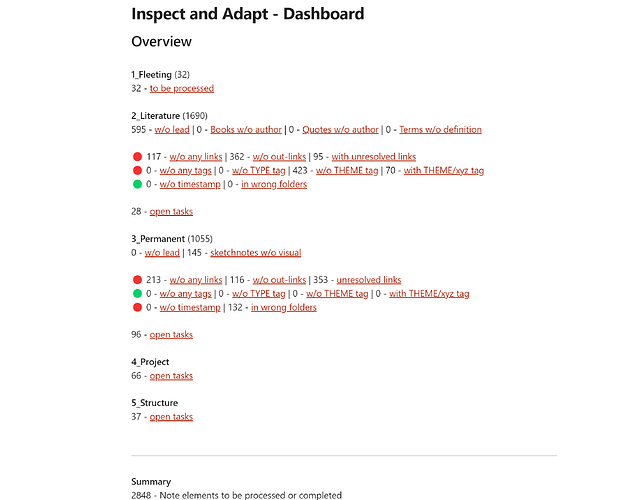And it’s very easy to start with a basic set of Tools for Gardening. Here is set of Structure Notes including simple Dataview queries. Feel free to modifiy these queries for your own purpose:
Having a Zettelkasten with lots of notes seems to be nice. But soon there will be a bunch of notes with ideas from an early stage in a rough form to some very developed ideas worth publishing. They are all mixed up in one big box of knowledge. This year I created a closer look on this mixture by defining a Maturity Level [1] for my notes.
And it was easy to filter these five Maturity Levels by given properties:
- Idea
Fleeting Note or Literature Note with basic concept or idea, initial thoughts or observations. Unstructured or raw content. Minimal use of links, tags, and metadata, but always kept a link to the source. Placeholder or generic title. Initial metadata includingcreatedandmodifieddate.
Filter: 1_Fleeting Notes OR 2_Literature Notes - Draft
Permanent Note with expanded content and more details. Preliminary organization of idea. Clear main points but may lack refinement. Basic use of links and tags for categorization. Improved title reflecting content. Use of template and addedthemeas mandatory metadata.
Filter: 3_Permanent Notes AND lead == null - In Progress
Permanent Note with substantially developed content. Logical structure with smooth transitions. Inclusion of supporting evidence or examples. Thoughtful use of links to connect concepts. Comprehensive tagging for efficient categorization. Title reflects the main theme. Summary is added asleadmetadata.
Filter: 3_Permanent Notes AND lead != null - Final
Permanent Note with completed, refined, and polished content. Consistent formatting and style. Ready for sharing, publication, or integration into larger projects. Thoughtfully crafted links for a comprehensive web of knowledge. Optimized tagging for easy retrieval and classification. Well-crafted title and a concise, informative summary. Comprehensive metadata with related contextual information.
Filter: 3_Permanent Notes AND #target/project - Published
Project Note that is decided to be is ready for publishing, shared with collaborators, or integrated into larger projects. Shared through preferred platform or collaborated with others. Gathered feedback from peers or collaborators. Incorporated constructive feedback to further improve the note. Updated metadata to reflect the latest version and any changes made.
Filter: 6_Project Notes
Do you also use a maturity level for your notes?
References
[1] Paulk, Mark C., ed. The Capability Maturity Model: Guidelines for Improving the Software Process . The SEI Series in Software Engineering. Reading, Mass: Addison-Wesley Pub. Co, 1995.
One of my favorit questions:
How can I improve my Zettelkasten?
As an expert in our field, we are likely to find an answer. However, why not consider a different perspective on potential solutions? Here’s a concept for thinking outside the box, beyond the confines of one’s own thoughts. The key to a wide array of solutions lies in adapting well-known principles or frameworks from established sciences or schools of thought.
Can you re-find your own solutions to improve your Zettelkasten?
References
- SimpleMind. Cross-platform Mind Mapping tools. 2024. https://simplemind.eu/.
- Zettelkasten Forum. ‘Principles to Improve Your Zettelkasten’, 18 February 2024. Principles to improve your Zettelkasten — Zettelkasten Forum.
- Zhao, Vicky. Getting Started with Framework Thinking. YouTube, 2022.
https://www.youtube.com/watch?v=U5xskQVA-2c.
Is it possible to compare different types of Zettelkasten [1]? I don’t think we can. - But we can compare numbers. And we can learn from the results.
How do we start learning? Let’s use some techniques from process mining [2], a method for identifying trends, patterns and details in the flow of a process. Process mining does this by applying data science to discover, validate and improve workflows.
Now let’s look at the diagram. It shows a process map with the basic elements of my Zettelkasten. They are connected by the flow of my notes. Added indicators show the number of notes per week that flow in a certain direction. Some more details are given in the table. They are used to establish a kind of baseline by showing a set of data and indicators from Luhmann’s Zettelkasten.
My way of learning is to ask questions. Although I am not Niklas Luhmann and use a different Zettelkasten, I want to ask myself the following questions:
- How many notes do I need to be prepared to write my first book?
- Would it be helpful to increase the number of new notes per year?
- How many notes will I have after five or ten years?
And I’m sure, your questions will be even better.
I’ll end with one of my favourite quotes from Cassie Kozyrkov, a former Chief Decision Scientist at Google: “Analytics doesn’t give you the answer, but it improves the quality of your questions.”
References
[1] Ahrens, Sönke. How to Take Smart Notes: One Simple Technique to Boost Writing, Learning and Thinking, 2022.
[2] Aalst, Wil M. P. van der. Process Mining: Data Science in Action . 2nd ed. 2016. Berlin, Heidelberg: Springer Berlin Heidelberg : Imprint: Springer, 2016.
Zettelkasten Metadata Management
To start my first Obsidian vault, I created a basic Zettelkasten system (Maturity Level 2, see [1]). This is a very simple approach involving five folders containing short notes, each with one idea, and links connecting related ideas in other notes. I was happy with it.
First I added tags to my notes (Maturity Level 3, see [1]). Then I discovered YAML and front matter with the concept of metadata. This is a simple concept for building a database from my notes (Maturity Level 4, see [1]). DataView and, nowadays, Bases could be used to automate my daily searches by enabling me to define queries on the fly. I was happy.
However, all my notes with metadata are created manually. Incorrect or inconsistent entries may produce inaccurate or confusing results. The ‘garbage in, garbage out’ rule still applies. I’m not always happy about that.
What about the key term ‘metadata management’? Is it a concept that could solve further complications?
Here is a preliminary analysis from my vault:
The actual data is shown in a Dasboard:
More about: Principles for Metadata Minimalism





